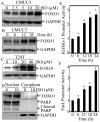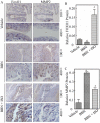Isorhapontigenin (ISO) Inhibits Invasive Bladder Cancer Formation In Vivo and Human Bladder Cancer Invasion In Vitro by Targeting STAT1/FOXO1 Axis
- PMID: 27080594
- PMCID: PMC4930725
- DOI: 10.1158/1940-6207.CAPR-15-0338
Isorhapontigenin (ISO) Inhibits Invasive Bladder Cancer Formation In Vivo and Human Bladder Cancer Invasion In Vitro by Targeting STAT1/FOXO1 Axis
Abstract
Although our most recent studies have identified Isorhapontigenin (ISO), a novel derivative of stilbene that isolated from a Chinese herb Gnetum cleistostachyum, for its inhibition of human bladder cancer growth, nothing is known whether ISO possesses an inhibitory effect on bladder cancer invasion. Thus, we addressed this important question in current study and discovered that ISO treatment could inhibit mouse-invasive bladder cancer development following bladder carcinogen N-butyl-N-(4-hydroxybutyl) nitrosamine (BBN) exposure in vivo We also found that ISO suppressed human bladder cancer cell invasion accompanied by upregulation of the forkhead box class O 1 (FOXO1) mRNA transcription in vitro Accordingly, FOXO1 was profoundly downregulated in human bladder cancer tissues and was negatively correlated with bladder cancer invasion. Forced expression of FOXO1 specifically suppressed high-grade human bladder cancer cell invasion, whereas knockdown of FOXO1 promoted noninvasive bladder cancer cells becoming invasive bladder cancer cells. Moreover, knockout of FOXO1 significantly increased bladder cancer cell invasion and abolished the ISO inhibition of invasion in human bladder cancer cells. Further studies showed that the inhibition of Signal transducer and activator of transcription 1 (STAT1) phosphorylation at Tyr701 was crucial for ISO upregulation of FOXO1 transcription. Furthermore, this study revealed that metalloproteinase-2 (MMP-2) was a FOXO1 downstream effector, which was also supported by data obtained from mouse model of ISO inhibition BBN-induced mouse-invasive bladder cancer formation. These findings not only provide a novel insight into the understanding of mechanism of bladder cancer's propensity to invasion, but also identify a new role and mechanisms underlying the natural compound ISO that specifically suppresses such bladder cancer invasion through targeting the STAT1-FOXO1-MMP-2 axis. Cancer Prev Res; 9(7); 567-80. ©2016 AACR.
©2016 American Association for Cancer Research.
Figures








Similar articles
-
Transcriptional and post-transcriptional upregulation of p27 mediates growth inhibition of isorhapontigenin (ISO) on human bladder cancer cells.Carcinogenesis. 2018 Mar 8;39(3):482-492. doi: 10.1093/carcin/bgy015. Carcinogenesis. 2018. PMID: 29409027 Free PMC article.
-
Isorhapontigenin induced cell growth inhibition and apoptosis by targeting EGFR-related pathways in prostate cancer.J Cell Physiol. 2018 Feb;233(2):1104-1119. doi: 10.1002/jcp.25968. Epub 2017 May 24. J Cell Physiol. 2018. PMID: 28422286
-
SESN2/sestrin 2 induction-mediated autophagy and inhibitory effect of isorhapontigenin (ISO) on human bladder cancers.Autophagy. 2016 Aug 2;12(8):1229-39. doi: 10.1080/15548627.2016.1179403. Epub 2016 May 12. Autophagy. 2016. PMID: 27171279 Free PMC article.
-
Investigation of the molecular mechanisms underlying the anti-inflammatory and antitumour effects of isorhapontigenin: Insights from in vitro and in vivo studies.Biomed Pharmacother. 2024 Nov;180:117479. doi: 10.1016/j.biopha.2024.117479. Epub 2024 Sep 25. Biomed Pharmacother. 2024. PMID: 39326106 Review.
-
Curcumin May Prevent Basement Membrane Disassembly by Matrix Metalloproteinases and Progression of the Bladder Cancer.Nutrients. 2021 Dec 23;14(1):32. doi: 10.3390/nu14010032. Nutrients. 2021. PMID: 35010907 Free PMC article. Review.
Cited by
-
FOXO transcription factor family in cancer and metastasis.Cancer Metastasis Rev. 2020 Sep;39(3):681-709. doi: 10.1007/s10555-020-09883-w. Cancer Metastasis Rev. 2020. PMID: 32372224 Free PMC article. Review.
-
Suppressed OGT expression inhibits cell proliferation while inducing cell apoptosis in bladder cancer.BMC Cancer. 2018 Nov 20;18(1):1141. doi: 10.1186/s12885-018-5033-y. BMC Cancer. 2018. PMID: 30453909 Free PMC article.
-
The inhibitory effect of compound ChlA-F on human bladder cancer cell invasion can be attributed to its blockage of SOX2 protein.Cell Death Differ. 2020 Feb;27(2):632-645. doi: 10.1038/s41418-019-0377-7. Epub 2019 Jun 26. Cell Death Differ. 2020. PMID: 31243344 Free PMC article.
-
Oncogenic role of MIR516A in human bladder cancer was mediated by its attenuating PHLPP2 expression and BECN1-dependent autophagy.Autophagy. 2021 Apr;17(4):840-854. doi: 10.1080/15548627.2020.1733262. Epub 2020 Mar 1. Autophagy. 2021. PMID: 32116109 Free PMC article.
-
Isorhapontigenin (ISO) inhibits EMT through FOXO3A/METTL14/VIMENTIN pathway in bladder cancer cells.Cancer Lett. 2021 Nov 1;520:400-408. doi: 10.1016/j.canlet.2021.07.041. Epub 2021 Jul 28. Cancer Lett. 2021. PMID: 34332039 Free PMC article.
References
-
- Siegel R, Ma J, Zou Z, Jemal A. Cancer statistics, 2014. CA Cancer J Clin. 2014;64:9–29. - PubMed
-
- Kaufman DS, Shipley WU, Feldman AS. Bladder cancer. Lancet. 2009;374:239–49. - PubMed
-
- Huang KS, Wang YH, Li RL, Lin M. Stilbene dimers from the lianas of Gnetum hainanense. Phytochemistry. 2000;54:875–81. - PubMed
MeSH terms
Substances
Grants and funding
LinkOut - more resources
Full Text Sources
Other Literature Sources
Medical
Molecular Biology Databases
Research Materials
Miscellaneous

